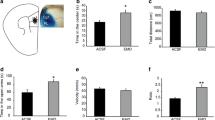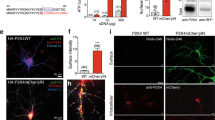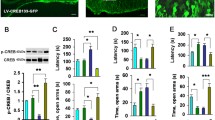Abstract
Rationale
5-HT1A receptor knockout (1AKO) mice have a robust anxiety phenotype. Tissue-specific “rescue” strategies and electrophysiology have implicated a critical role for postsynaptic 5-HT1A receptors, particularly in the CA1 region of the hippocampus.
Objectives
In this study, we evaluated differences in membrane properties and synaptic activity in CA1 hippocampal pyramidal cells between 1AKOs and wild-type (WT) controls to better understand the cellular correlates of anxiety in this mouse model.
Methods
Whole-cell patch-clamp recordings were conducted in CA1 pyramidal cells in hippocampal brain slices from 1AKOs and WTs that had previously been screened for anxiety with the elevated-plus maze. Spontaneous miniature inhibitory and excitatory postsynaptic currents (IPSCs and EPSCs) and stimulus-evoked eIPSCs and eEPSCs were recorded in addition to the effect of the benzodiazepine agonist diazepam or the inverse agonist FG 7142 on γ-aminobutyric acid (GABA)ergic eIPSCs.
Results
Evoked EPSC amplitude was greater in 1AKOs than WTs. When subjects were pooled across genotypes, anxiety measures correlated with eEPSC amplitude, indicating enhanced postsynaptic glutamate synaptic activity under conditions of synaptic activation in anxious subjects. While GABA synaptic activity and sensitivity to diazepam were not affected by genotype or correlated with anxiety, sensitivity to the anxiogenic FG 7142 was smaller in anxious subjects.
Conclusions
These data indicate enhanced postsynaptic glutamate receptor sensitivity and decreased GABAergic inhibition by a benzodiazepine inverse agonist in CA1 hippocampal neurons of anxious mice are produced by deletion of the 5-HT1A receptor. These data provide new information about interactions between 5-HT, GABA, and glutamate systems during the expression of chronic anxiety.





Similar content being viewed by others
References
Adhikari A, Topiwala MA, Gordon JA (2010) Synchronized activity between the ventral hippocampus and the medial prefrontal cortex during anxiety. Neuron 65:257–269
Allan AM, Baier LD, Zhang X (1992) Effects of lorazepam tolerance and withdrawal on GABAA receptor-operated chloride channels. J Pharmacol Exp Ther 261:395–402
Andrews N, Hogg S, Gonzalez LE, File SE (1994) 5-HT1A receptors in the median raphe nucleus and dorsal hippocampus may mediate anxiolytic and anxiogenic behaviours respectively. Eur J Pharmacol 264:259–264
Appenrodt E, Kroning G, Schwarzberg H (1999) Increased plasma ACTH in rats exposed to the elevated plus-maze is independent of the pineal gland. Psychoneuroendocrinology 24:833–838
Bailey SJ, Toth M (2004) Variability in the benzodiazepine response of serotonin 5-HT1A receptor null mice displaying anxiety-like phenotype: evidence for genetic modifiers in the 5-HT-mediated regulation of GABA(A) receptors. J Neurosci 24:6343–6351
Barbaccia ML, Costa E, Ferrero P, Guidotti A, Roy A, Sunderland T, Pickar D, Paul SM, Goodwin FK (1986) Diazepam-binding inhibitor. A brain neuropeptide present in human spinal fluid: studies in depression, schizophrenia, and Alzheimer’s disease. Arch Gen Psychiatry 43:1143–1147
Bourin M, Hascoet M (2001) Drug mechanisms in anxiety. Curr Opin Investig Drugs 2:259–265
Britton KT, Lee G, Koob GF (1988) Corticotropin releasing factor and amphetamine exaggerate partial agonist properties of benzodiazepine antagonist Ro 15-1788 in the conflict test. Psychopharmacol (Berl) 94:306–311
Cagetti E, Liang J, Spigelman I, Olsen RW (2003) Withdrawal from chronic intermittent ethanol treatment changes subunit composition, reduces synaptic function, and decreases behavioral responses to positive allosteric modulators of GABAA receptors. Mol Pharmacol 63:53–64
Calogero AE, Gallucci WT, Chrousos GP, Gold PW (1988) Interaction between GABAergic neurotransmission and rat hypothalamic corticotropin-releasing hormone secretion in vitro. Brain Res 463:28–36
Carli M, Tatarczynska E, Cervo L, Samanin R (1993) Stimulation of hippocampal 5-HT1A receptors causes amnesia and anxiolytic-like but not antidepressant-like effects in the rat. Eur J Pharmacol 234:215–221
Charney DS, Drevets WC (2002) Neurobiological basis of anxiety disorders. In: Davis KL, Charney DS, Coyle J, Nemeroff C (eds) Neuropsychopharmacology: the Fifth Generation of Progress. American College of Neuropsychopharmacology. Lippincott Williams & Wilkins, Baltimore, MD, pp 901–930
Cossart R, Epsztein J, Tyzio R, Becq H, Hirsch J, Ben-Ari Y, Crepel V (2002) Quantal release of glutamate generates pure kainate and mixed AMPA/kainate EPSCs in hippocampal neurons. Neuron 35:147–159
Costa E, Guidotti A (1991) Diazepam binding inhibitor (DBI): a peptide with multiple biological actions. Life Sci 49:325–344
Crawley JN (1996) Unusual behavioral phenotypes of inbred mouse strains. Trends Neurosci 19:181–182
Crawley J (2007) What’s wrong with my mouse: behavioral phenotyping of transgenic and knockout mice. John Wiley and Sons, Hoboken
Dos SL, De Andrade TG, Zangrossi JH (2008) 5-HT1A receptors in the dorsal hippocampus mediate the anxiogenic effect induced by the stimulation of 5-HT neurons in the median raphe nucleus. Eur Neuropsychopharmacol 18:286–294
Fanselow MS, Dong HW (2010) Are the dorsal and ventral hippocampus functionally distinct structures? Neuron 65:7–19
File SE (2001) Factors controlling measures of anxiety and responses to novelty in the mouse. Behav Brain Res 125:151–157
File SE, Gonzalez LE (1996) Anxiolytic effects in the plus-maze of 5-HT1A-receptor ligands in dorsal raphe and ventral hippocampus. Pharmacol Biochem Behav 54:123–128
File SE, Gonzalez LE, Andrews N (1996) Comparative study of pre- and postsynaptic 5-HT1A receptor modulation of anxiety in two ethological animal tests. J Neurosci 16:4810–4815
File SE, Mabbutt PS, Hitchcott PK (1990) Characterisation of the phenomenon of “one-trial tolerance” to the anxiolytic effect of chlordiazepoxide in the elevated plus-maze. Psychopharmacol (Berl) 102:98–101
File SE, Zangrossi H Jr, Sanders FL, Mabbutt PS (1994) Raised corticosterone in the rat after exposure to the elevated plus-maze. Psychopharmacol (Berl) 113:543–546
Freund TF, Buzsaki G (1996) Interneurons of the hippocampus. Hippocampus 6:347–470
Gerlai R (2001) Gene targeting: technical confounds and potential solutions in behavioral brain research. Behav Brain Res 125:13–21
Gordon JA, Lacefield CO, Kentros CG, Hen R (2005) State-dependent alterations in hippocampal oscillations in serotonin 1A receptor-deficient mice. J Neurosci 25:6509–6519
Graeff FG, Guimaraes FS, De Andrade TG, Deakin JF (1996) Role of 5-HT in stress, anxiety, and depression. Pharmacol Biochem Behav 54:129–141
Gray JA, McNaughton N (2003) The neuropsychology of anxiety: an enquiry into the function of the septo-hippocampal system. Oxford University Press, Oxford
Griebel G, Moreau JL, Jenck F, Martin JR, Misslin R (1993) Some critical determinants of the behavior of rats in the elevated plus-maze. Behav Process 29:37–47
Gross C, Zhuang X, Stark K, Ramboz S, Oosting R, Kirby L, Santarelli L, Beck S, Hen R (2002) Serotonin1A receptor acts during development to establish normal anxiety-like behaviour in the adult. Nature 416:396–400
Heisler LK, Chu HM, Brennan TJ, Danao JA, Bajwa P, Parsons LH, Tecott LH (1998) Elevated anxiety and antidepressant-like responses in serotonin 5-HT1A receptor mutant mice. Proc Natl Acad Sci USA 95:15049–15054
Hogg S (1996) A review of the validity and variability of the elevated plus-maze as an animal model of anxiety. Pharmacol Biochem Behav 54:21–30
Hogg S, Andrews N, File SE (1994) Contrasting behavioural effects of 8-OH DPAT in the dorsal raphe nucleus and ventral hippocampus. Neuropharmacology 33:343–348
Jacobson L, Sapolsky RM (1991) The role of the hippocampus in feedback regulation of the hypothalamic-pituitary-adrenocortical axis. Endocr Rev 12:118–134
Jolas T, Schreiber R, Laporte AM, Chastanet M, De VJ, Glaser T, Adrien J, Hamon M (1995) Are postsynaptic 5-HT1A receptors involved in the anxiolytic effects of 5-HT1A receptor agonists and in their inhibitory effects on the firing of serotonergic neurons in the rat? J Pharmacol Exp Ther 272:920–929
Kataoka Y, Shibata K, Miyazaki A, Inoue Y, Tominaga K, Koizumi S, Ueki S, Niwa M (1991) Involvement of the dorsal hippocampus in mediation of the antianxiety action of tandospirone, a 5-hydroxytryptamine1A agonistic anxiolytic. Neuropharmacology 30:475–480
Kostowski W, Plaznik A, Stefanski R (1989) Intra-hippocampal buspirone in animal models of anxiety. Eur J Pharmacol 168:393–396
Lacaille JC, Mueller AL, Kunkel DD, Schwartzkroin PA (1987) Local circuit interactions between oriens/alveus interneurons and CA1 pyramidal cells in hippocampal slices: electrophysiology and morphology. J Neurosci 7:1979–1993
Lister RG (1987) The use of a plus-maze to measure anxiety in the mouse. Psychopharmacol (Berl) 92:180–185
Lo IL, Gross C (2008) Alpha-Ca2+/calmodulin-dependent protein kinase II contributes to the developmental programming of anxiety in serotonin receptor 1A knock-out mice. J Neurosci 28:6250–6257
Lucki I (1996) Serotonin receptor specificity in anxiety disorders. J Clin Psychiatry 57 Suppl 6:5–10
Maguire JL, Stell BM, Rafizadeh M, Mody I (2005) Ovarian cycle-linked changes in GABA(A) receptors mediating tonic inhibition alter seizure susceptibility and anxiety. Nat Neurosci 8:797–804
Mayorga AJ, Dalvi A, Page ME, Zimov-Levinson S, Hen R, Lucki I (2001) Antidepressant-like behavioral effects in 5-hydroxytryptamine(1A) and 5-hydroxytryptamine(1B) receptor mutant mice. J Pharmacol Exp Ther 298:1101–1107
McEwen BS (2007) Physiology and neurobiology of stress and adaptation: central role of the brain. Physiol Rev 87:873–904
McEwen BS, Gould EA, Sakai RR (1992) The vulnerability of the hippocampus to protective and destructive effects of glucocorticoids in relation to stress. Br J Psychiatry 15(Suppl):18–23
McEwen BS, Magarinos AM (1997) Stress effects on morphology and function of the hippocampus. Ann NY Acad Sci 821:271–284
Menard J, Treit D (1998) The septum and the hippocampus differentially mediate anxiolytic effects of R(+)-8-OH-DPAT. Behav Pharmacol 9:93–101
Menard J, Treit D (1999) Effects of centrally administered anxiolytic compounds in animal models of anxiety. Neurosci Biobehav Rev 23:591–613
Millan MJ (2003) The neurobiology and control of anxious states. Prog Neurobiol 70:83–244
Neumeister A, Bain E, Nugent AC, Carson RE, Bonne O, Luckenbaugh DA, Eckelman W, Herscovitch P, Charney DS, Drevets WC (2004) Reduced serotonin type 1A receptor binding in panic disorder. J Neurosci 24:589–591
Parks CL, Robinson PS, Sibille E, Shenk T, Toth M (1998) Increased anxiety of mice lacking the serotonin1A receptor. Proc Natl Acad Sci USA 95:10734–10739
Pattij T, Groenink L, Oosting RS, van der GJ M, RA OB (2002) GABA(A)-benzodiazepine receptor complex sensitivity in 5-HT(1A) receptor knockout mice on a 129/Sv background. Eur J Pharmacol 447:67–74
Pellow S, Chopin P, File SE, Briley M (1985) Validation of open:closed arm entries in an elevated plus-maze as a measure of anxiety in the rat. J Neurosci Methods 14:149–167
Phillips TJ, Hen R, Crabbe JC (1999) Complications associated with genetic background effects in research using knockout mice. Psychopharmacol (Berl) 147:5–7
Ramboz S, Oosting R, Amara DA, Kung HF, Blier P, Mendelsohn M, Mann JJ, Brunner D, Hen R (1998) Serotonin receptor 1A knockout: an animal model of anxiety-related disorder. Proc Natl Acad Sci USA 95:14476–14481
Ravindran LN, Stein MB (2010) The pharmacologic treatment of anxiety disorders: a review of progress. J Clin Psychiatry 71:839–854
Rodgers RJ, Haller J, Holmes A, Halasz J, Walton TJ, Brain PF (1999) Corticosterone response to the plus-maze: high correlation with risk assessment in rats and mice. Physiol Behav 68:47–53
Rodgers RJ, Lee C, Shepherd JK (1992) Effects of diazepam on behavioural and antinociceptive responses to the elevated plus-maze in male mice depend upon treatment regimen and prior maze experience. Psychopharmacol (Berl) 106:102–110
Rodgers RJ, Shepherd JK (1993) Influence of prior maze experience on behaviour and response to diazepam in the elevated plus-maze and light/dark tests of anxiety in mice. Psychopharmacol (Berl) 113:237–242
Sandford JJ, Argyropoulos SV, Nutt DJ (2000) The psychobiology of anxiolytic drugs. Part 1: Basic neurobiology. Pharmacol Ther 88:197–212
Sarnyai Z, Sibille EL, Pavlides C, Fenster RJ, McEwen BS, Toth M (2000) Impaired hippocampal-dependent learning and functional abnormalities in the hippocampus in mice lacking serotonin(1A) receptors. Proc Natl Acad Sci USA 97:14731–14736
Schreiber R, De Vry J (1993) Neuronal circuits involved in the anxiolytic effects of the 5-HT1A receptor agonists 8-OH-DPAT ipsapirone and buspirone in the rat. Eur J Pharmacol 249:341–351
Sibille E, Pavlides C, Benke D, Toth M (2000) Genetic inactivation of the Serotonin(1A) receptor in mice results in downregulation of major GABA(A) receptor alpha subunits, reduction of GABA(A) receptor binding, and benzodiazepine-resistant anxiety. J Neurosci 20:2758–2765
Skelton KH, Nemeroff CB, Knight DL, Owens MJ (2000) Chronic administration of the triazolobenzodiazepine alprazolam produces opposite effects on corticotropin-releasing factor and urocortin neuronal systems. J Neurosci 20:1240–1248
Smith SS, Gong QH, Li X, Moran MH, Bitran D, Frye CA, Hsu FC (1998) Withdrawal from 3alpha-OH-5alpha-pregnan-20-One using a pseudopregnancy model alters the kinetics of hippocampal GABAA-gated current and increases the GABAA receptor alpha4 subunit in association with increased anxiety. J Neurosci 18:5275–5284
Stefanski R, Palejko W, Bidzinski A, Kostowski W, Plaznik A (1993) Serotonergic innervation of the hippocampus and nucleus accumbens septi and the anxiolytic-like action of midazolam and 5-HT1A receptor agonists. Neuropharmacology 32:977–985
Treit D, Menard J, Royan C (1993) Anxiogenic stimuli in the elevated plus-maze. Pharmacol Biochem Behav 44:463–469
Van Sickle BJ, Xiang K, Tietz EI (2004) Transient plasticity of hippocampal CA1 neuron glutamate receptors contributes to benzodiazepine withdrawal-anxiety. Neuropsychopharmacology 29:1994–2006
Acknowledgments
We thank Drs. Mark Geyer and Victoria Risbrough in the Dept. of Psychiatry at the University of California, San Diego for the generous donation of breeding pairs of 129/Sv 5-HT1A knockout mice and wild-type controls for use in these studies. We thank Alessandra Cathel for her technical assistance and contributions to electrophysiological studies. This work was supported by a Young Investigator Award from the National Association of Research on Schizophrenia and Depression (NARSAD) and a National Institute of Mental Health grant (MH 63301) issued to Dr. Kirby and by National Institute of Mental Health grants (MH 48125 and MH 63078) issued to Dr. Beck.
Author information
Authors and Affiliations
Corresponding author
Rights and permissions
About this article
Cite this article
Freeman-Daniels, E., Beck, S.G. & Kirby, L.G. Cellular correlates of anxiety in CA1 hippocampal pyramidal cells of 5-HT1A receptor knockout mice. Psychopharmacology 213, 453–463 (2011). https://doi.org/10.1007/s00213-010-2030-5
Received:
Accepted:
Published:
Issue Date:
DOI: https://doi.org/10.1007/s00213-010-2030-5




